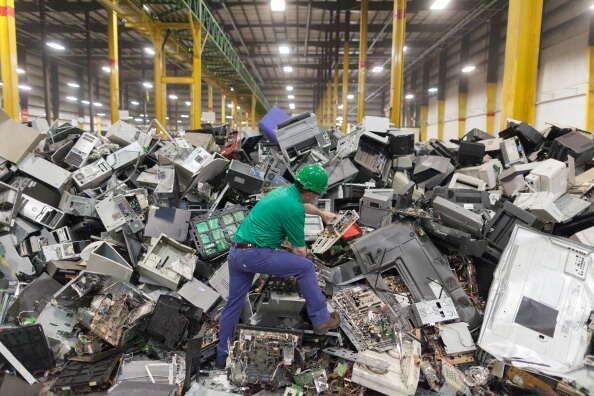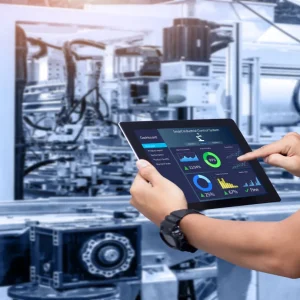
The issue of electronic waste was once described by the UN’s environment chief as a “tsunami rolling out over the world.” Seven years on, the mounting problem of how to dispose of and recycle the world’s e-waste remains a critical issue at the forefront of the sustainability agenda.
But where is all this e-waste coming from? And what can governments and businesses alike do to safely dispose of the materials contained inside?

What is e-waste?
The term e-waste simply refers to any discarded appliances using electricity, or anything that uses an electric power supply that has reached the end of its life. This might include a wide range of products, from large household devices such as refrigerators, air conditioners, cell phones, personal stereos and consumer electronics, to computers that have been discarded by their users.
Estimates suggest that the volume of such items is increasing – and rapidly. In 2020, the United Nations Global E-waste Monitor conservatively estimated that 294.4 million tonnes of e-waste were produced over the previous six years. That same report concluded that that same total would almost double by the end of 2023, to 528 million tonnes.
What are the biggest sources of e-waste?
Perhaps unsurprisingly, household appliances make up the biggest share of all e-waste produced. According to the EU’s official statistics agency, e-waste consisting of small and large household appliances made up more than 30 metric tonnes of the total volume of electronic equipment collected inside the bloc in 2020.
These household appliances include large, bulky items such as washing machines, cookers and dishwashers, as well as smaller items like microwaves, vacuum cleaners, fans and kettles. Other appliances that involve the use of temperature exchange equipment like air conditioners, refrigerators and freezers also made up a significant amount of e-waste collected by the EU that year.
E-waste from the IT sector, meanwhile, made up more than ten metric tonnes of e-waste, according to Eurostat. This includes everyday items used in the industry, from monitors to laptops, as well as wireless routers, GPS devices and LED monitors.
Where does e-waste end up?
Images of people sorting through large piles of discarded electronic goods in South and East Asia are commonly associated with e-waste. However, a 2019 investigation from the Basel Action Network (BAN) found that some e-waste also ends up in richer, European countries, albeit those with more formal recycling processes.
Researchers from BAN attached GPS trackers on more than 300 units of printers, LCD monitors and computers placed in recycling facilities in ten countries to understand where exactly e-waste ends up. While some items were found to be shipped to places like Belgium, Austria and Hungary, the bulk of e-waste from Europe was exported to Ghana, Nigeria, Pakistan, Tanzania and Thailand.
E-waste is categorised by the European Union as ‘hazardous waste’ due to the wide range of toxic parts often found inside electronic products, such as mercury, lead and flame retardants. Exports of e-waste to non-OECD and non-EU countries have been made illegal under EU law.
That same report by BAN found that the UK exported the largest amount of e-waste shipments to developing countries, affixing GPS devices to five computer and LCD monitors that travelled via recycling centres in England and Scotland to dumps in Pakistan, Nigeria and Ghana. Africa in particular remains a hotspot of e-waste, with the authors finding that 64% of the EU’s total exports of the refuse ended up in the continent.
What are the most harmful chemicals in e-waste?
All of this discarded electronic equipment contains extremely harmful materials that not only pose significant risks to individuals’ health but also degrade the local environment. For example, large amounts of e-waste containing arsenic found in mobile phones placed in landfills pollute soil and groundwater. Personal exposure to these materials, meanwhile, can increase the chances of developing lung cancer, nerve damage and a variety of skin diseases.
These risks are heightened at informal disposal sites. According to a recent study conducted by researchers at the Lancet Planetary Health group, most e-waste recycling happens at these dumps, with the recovery of materials “generally carried out without personal protective equipment or modern technology.” Furthermore, these informal practices can involve the open burning of electronic equipment and manual dismantling, further exposing workers on-site and those living nearby to harmful chemicals via “inhalation, ingestion, and dermal absorption.” Infants and children exposed to e-waste also carry a heightened risk of obesity, asthma, or neurodevelopmental disorders, according to the Lancet study.
What are governments doing to clean up e-waste?
Despite the scale of the problem, a majority of countries do not have laws on the books to either recycle e-waste or ban the importation of such materials. Analysis of national legislation from the Geneva Internet Platform finds that only 32 have some form of policy in place to address the e-waste problem. A further 73 countries, meanwhile, do not have any plans at all.
Certain countries, however, have pioneered tighter regulations on the disposal of e-waste. India, for example, has had such laws in place since 2011. It has been followed since then by Thailand, which imposed new restrictions on e-waste imports in 2018 after a widespread public backlash against the practice, and China, which last year announced an outright ban on such materials being imported from Europe.
Even these countries face massive problems in contending with the rising volume of discarded electrical products. The US, China and India remain the world’s largest producers of e-waste as of July 2022, according to the UN’s Global E-waste Monitor, producing almost 20 kilo-tonnes of e-waste in the last year – more than the next seven countries' biggest producers combined. And while the Big Three continue to assert their intention to increase their recycling rates for e-waste, they have struggled to do so, at least in comparison with European nations such as Germany, France and the UK.
How to solve e-waste
Circular economy approaches have been proposed as the solution to tackle the growing problem of e-waste. Telecommunications companies have been leading the charge against e-waste. Vodafone, for example, has claimed to have recycled 99% of the 8,800 tonnes of waste it produced so far this year. Its internal asset marketplace initiative, meanwhile, has also seen the company slash its C02 emissions by 2,500 tonnes.
Other companies like Virgin Media O2 have also implemented a ‘Tech Lending Community Fund’, which provides grants of up to 120,000 to councils and community groups in the UK to purchase refurbished devices to loan to refugees, ex-convicts and domestic abuse survivors.
But sustainability experts are warning that how we collect and distribute e-waste is the most important factor when considering circular economy approaches. Understanding the scale of your organisation’s e-waste problem, and setting realistic targets to recycle discarded electronic items, will go a long way towards achieving sustainability goals not only for the company, but future generations as well.






